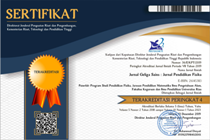DEVELOPMENT OF EARTHQUAKE DEMONSTRATION TOOL AS A PHYSICS SCIENCE LEARNING MEDIA
Abstract
The creation of interactive learning activities can be influenced by the availability of media and learning resources as a useful tool in teaching and learning activities. The effectiveness of students' absorption of difficult and complicated learning materials can be achieved with the help of the demonstration tool as a media. The purpose of this research is to produce an earthquake demonstration tool, as a valid learning media for use in the learning process of physics in junior high schools. This development research uses the R & D method which was adapted from Nieveen & Folmer with three-phase, namely: preliminary research, development or prototyping phase, and the formative evaluation within the development stage. The evaluation of the validation of the media uses the instrument of validation of the earthquake demonstration tool with 5 indicators and the assessment of validation of the guidebook with 4 indicators. The results of the design of the media obtained the validation score for the earthquake demonstration tool with a score of 4.5 where a very valid category and the handbook obtained a validation score of 4.4 with a very valid category. Based on the results of this research, an earthquake demonstration tool had been successfully made and a guidebook for its use as a physics science learning media is valid and suitable for use in junior high schools.
Keywords
Full Text:
PDFReferences
Deassy & Wahono. (2017). Pengembangan kit struktur bumi dan simulasi gempa sebagai media pembelajaran untuk meningkatkan keterampilan berpikir kritis siswa kelas VII. E-Journal Unesa, 5(2), 83-91.
www.jurnalmahasiswa.unesa.ac.id (diakses 11 April 2019).
Dimayati & Mudjiono. (2006). Belajar dan Pembelajaran. Jakarta: PT Rineke Cipta.
Farida Huriawati & Andista Candra. (2016). Pengembangan odd "osilator digital detector" sebagai alat peraga praktikum gerak harmonik sederhana. Jurnal Inovasi dan Pembelajaran Fisika. ISSN: 2355-7109. FKIP Universitas Sriwijaya. Sumatra Selatan.
Huda, M. (2014). Model-model Pengajaran dan Pembeleajaran. Yogyakarta: Pustaka Pelajar.
Kemp, J.E & Dayton, D.K. (1985). Planning and Producing Instructional Media. New York: Cambidge Harper & Row Publisher.
M. Rahmad, Dina Syaflita, M. Nor, & Metty Susanti. (2019). Needs Analysis of Air Quality Detection Tool in Project Based Learning. J. Phys.: Conf. Ser. 1351 012066. IOP Publishing, doi:10.1088/1742-6596/1351/1/012066.
Nieveen, N., & Folmer, E. (2011). Formative evaluation in educational design research. dalam T. Plomp & Nieveen,(Eds), An Introduction to Educational Design Research. The-Netherlands: SLO.
Permendiknas. (2013). Permendiknas nomor 69 tahun 2013 tentang kerangka dasar dan struktur kurikulum sekolah menengah. Jakarta: Departemen Pendidikan Nasional.
Rahayuningsih & Dwiyanto. (2005). Pembelajaran di Laboratorium. Yogyakarta: Pusat Pengembangan Pendidikan UGM.
Surya, Mohd. (2003). Psikologi Pembelajaran dan Pengajaran, Cet. II. Bandung: Yayasan Bhakti Winaya.
Syaiful Bahri, Djamarah & Zain. (2005). Guru dan Anak Didik dalam Interaksi Anak Didik. Jakarta: Rineka Cipta.
Syaiful Sagala. (2014). Konsep dan makna pembelajaran. Bandung: Alfabeta.
Tessmer, Martin. (2005). Planning and Conducting Formative Evaluations: Improving the Quality of Education and Training. London: Routledge.
Zulirfan, Zanaton, H.I., & Tamby Subahan, M.M. (2017). Pengembangan Kit Take-Home Experiment Cahaya Dan Optik Sebagai Media Pembelajaran Sains Siswa Sltp. Jurnal Geliga Sains, 5(1), 1-7.
DOI: http://dx.doi.org/10.31258/jgs.8.1.1-8
Refbacks
- There are currently no refbacks.
Copyright (c) 2020 Wuly Gunawan, M Nor, Hendar Sudrajad

This work is licensed under a Creative Commons Attribution 4.0 International License.
Jurnal ini terdaftar dan terindeks pada:
- Crossref
- Google Scholar
- Crossref
- Garuda
- Sinta
- Researchgate
- Dimensions
- Base
- Scilit
- OneSearch
- Road
- CiteFactor
- ResearchBib
- WorldCat



















